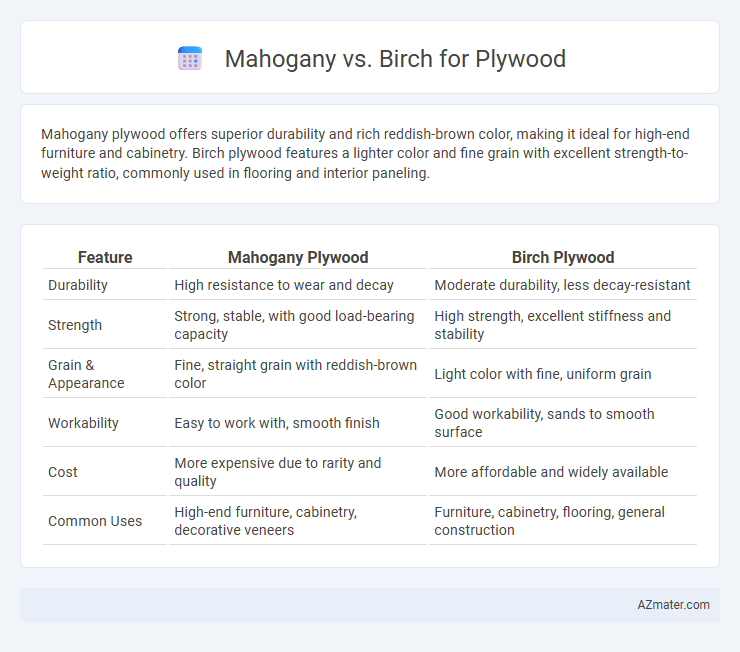Mahogany plywood offers superior durability and rich reddish-brown color, making it ideal for high-end furniture and cabinetry. Birch plywood features a lighter color and fine grain with excellent strength-to-weight ratio, commonly used in flooring and interior paneling.
Table of Comparison
| Feature | Mahogany Plywood | Birch Plywood |
|---|---|---|
| Durability | High resistance to wear and decay | Moderate durability, less decay-resistant |
| Strength | Strong, stable, with good load-bearing capacity | High strength, excellent stiffness and stability |
| Grain & Appearance | Fine, straight grain with reddish-brown color | Light color with fine, uniform grain |
| Workability | Easy to work with, smooth finish | Good workability, sands to smooth surface |
| Cost | More expensive due to rarity and quality | More affordable and widely available |
| Common Uses | High-end furniture, cabinetry, decorative veneers | Furniture, cabinetry, flooring, general construction |
Introduction to Mahogany and Birch Plywood
Mahogany plywood is renowned for its rich color, fine grain, and exceptional durability, making it a popular choice for high-end furniture and cabinetry. Birch plywood offers a lighter color with a smooth surface, known for its strength and resistance to warping, commonly used in construction and interior applications. Both woods provide excellent stability, but mahogany is preferred for aesthetic appeal while birch is favored for structural integrity.
Wood Characteristics and Appearance
Mahogany plywood features a rich, reddish-brown color with a fine, straight grain that offers excellent dimensional stability and resistance to warping, making it ideal for high-end furniture and cabinetry. Birch plywood presents a lighter, creamy color with a uniform and smooth grain pattern, known for its strength, hardness, and smooth finish that is well-suited for structural applications and painted surfaces. Both woods provide durable plywood options, but mahogany excels in aesthetic appeal and stability, while birch is favored for cost-effectiveness and versatility in finishing.
Strength and Durability Comparison
Mahogany plywood offers superior strength and durability compared to birch plywood, making it ideal for heavy-duty applications and high-traffic areas. Mahogany's dense grain structure provides enhanced moisture resistance and resistance to warping, extending the lifespan of finished products. Birch plywood, while strong and stable, is generally less resistant to environmental stress and is better suited for indoor use where load demands are moderate.
Workability and Ease of Fabrication
Mahogany plywood offers superior workability due to its consistent grain and smooth texture, making it easier to cut, shape, and sand without splintering. Birch plywood, while slightly harder and denser, provides excellent dimensional stability and holds fasteners well but may require sharper tools and more effort during fabrication. Both materials are favored for cabinetry and furniture, but mahogany is preferred for intricate detailing, whereas birch suits applications demanding durability and structural integrity.
Moisture Resistance and Stability
Mahogany plywood offers superior moisture resistance due to its dense, oily grain structure, making it ideal for humid environments and outdoor applications. Birch plywood, while less resistant to moisture, provides exceptional dimensional stability and strength, ensuring minimal warping and durability under fluctuating conditions. Choosing between mahogany and birch plywood depends on the balance of moisture resistance needs and stability requirements for specific projects.
Applications and Common Uses
Mahogany plywood is highly favored for luxury furniture, cabinetry, and decorative veneers due to its rich color, durability, and fine grain. Birch plywood excels in structural applications, flooring, and industrial uses because of its strength, smooth surface, and resistance to warping. Both materials are commonly chosen based on the balance between aesthetic appeal and mechanical performance, with mahogany preferred for visible finishes and birch for robust, functional components.
Cost and Availability
Mahogany plywood typically commands a higher price due to its premium quality, rich color, and durability, making it less readily available compared to birch plywood. Birch plywood is more cost-effective and widely accessible, favored for its smooth surface, strength, and consistent supply in the lumber market. Choosing between mahogany and birch plywood depends largely on budget constraints and the desired aesthetic or structural application.
Environmental Impact and Sustainability
Mahogany plywood generally has a higher environmental impact due to slower growth rates and challenges in sustainable harvesting, often linked to deforestation in tropical regions. Birch plywood, sourced mainly from fast-growing, sustainably managed forests in the northern hemisphere, offers a more eco-friendly option with better carbon sequestration and lower habitat disruption. Choosing birch over mahogany plywood supports sustainable forestry practices and reduces ecological footprint in construction and furniture projects.
Maintenance and Longevity
Mahogany plywood offers superior resistance to moisture, insects, and warping, resulting in lower maintenance requirements and a longer lifespan compared to birch plywood. Birch plywood, while durable and strong, is more susceptible to water damage and may require regular sealing or varnishing to maintain its integrity over time. Choosing mahogany plywood ensures enhanced durability with minimal upkeep, making it ideal for high-moisture or outdoor applications.
Conclusion: Choosing Between Mahogany and Birch Plywood
Mahogany plywood offers superior durability, rich color, and resistance to moisture, making it ideal for high-end furniture and marine applications. Birch plywood provides a smooth finish, consistent grain, and excellent strength-to-weight ratio, suited for cabinetry and interior projects requiring precision and affordability. Selecting between mahogany and birch plywood depends on balancing the need for aesthetic appeal and environmental resistance against budget constraints and project specifications.

Infographic: Mahogany vs Birch for Plywood
 azmater.com
azmater.com